Analyzing the Impact of IoT on Business Transformation and Growth
VerifiedAdded on 2022/08/14
|5
|1463
|12
Essay
AI Summary
This essay examines the transformative impact of the Internet of Things (IoT) on modern business operations. It defines IoT as a network of devices and sensors that provide data and analytics, highlighting its exponential growth with over 7 billion IoT devices globally in 2018. The essay details how IoT technologies are used to monitor procedures, improve business insights, enhance customer experience, reduce operational costs, and create new revenue streams, citing Walt Disney World's MagicBand and Harley-Davidson's manufacturing optimization as real-world examples. It also explores the benefits for both internal users (employees, supervisors) through enhanced safety and external users (customers) through personalized experiences. The essay acknowledges challenges such as security concerns, hardware updates, and regulatory compliance but concludes that the benefits of IoT outweigh these concerns, positioning it as a crucial tool for businesses seeking a competitive edge in the digital era. It emphasizes that by meeting customer expectations, reducing operational costs, and fostering innovation, IoT enables businesses to achieve their key objectives and secure long-term success.
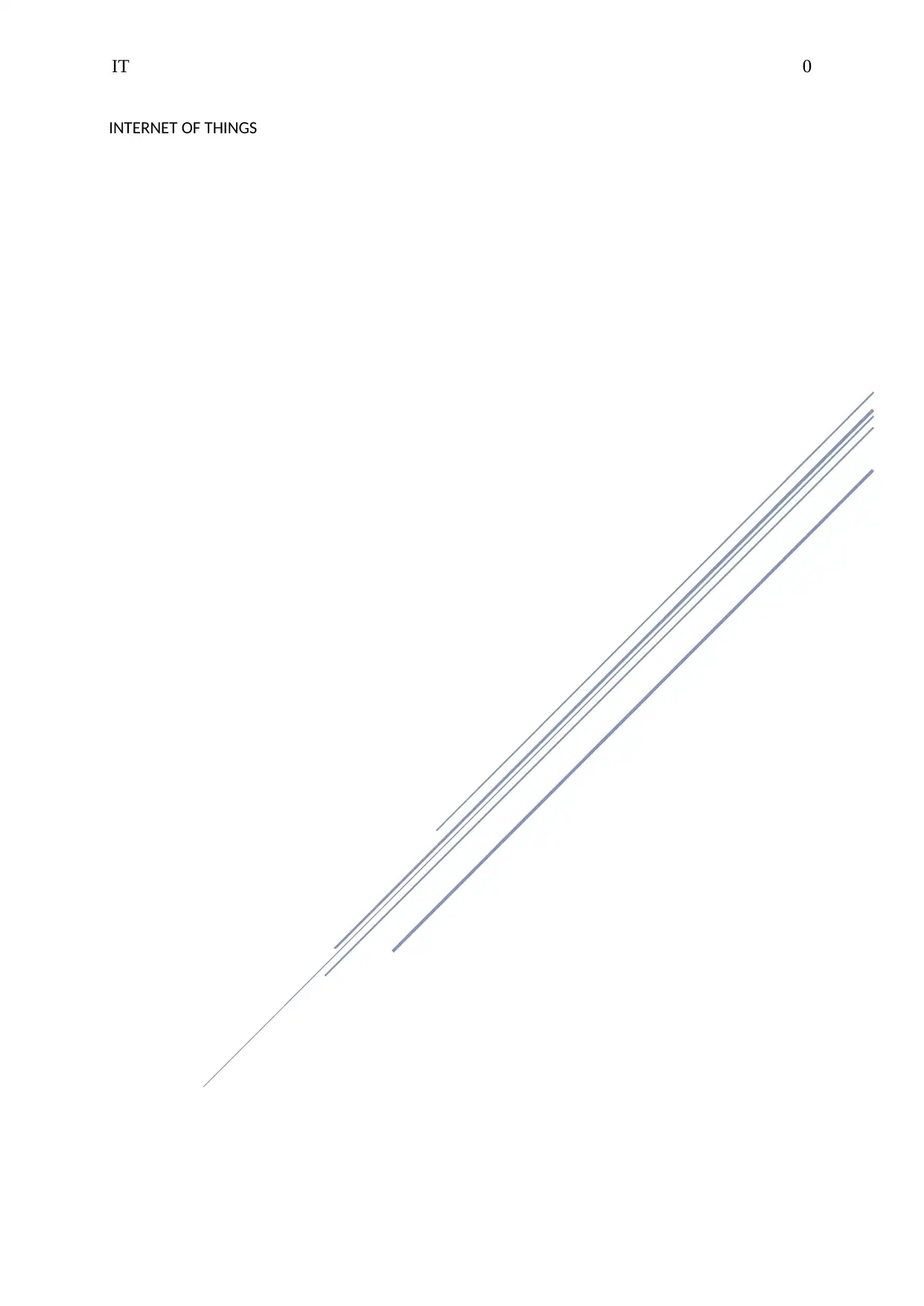
IT 0
INTERNET OF THINGS
INTERNET OF THINGS
Paraphrase This Document
Need a fresh take? Get an instant paraphrase of this document with our AI Paraphraser
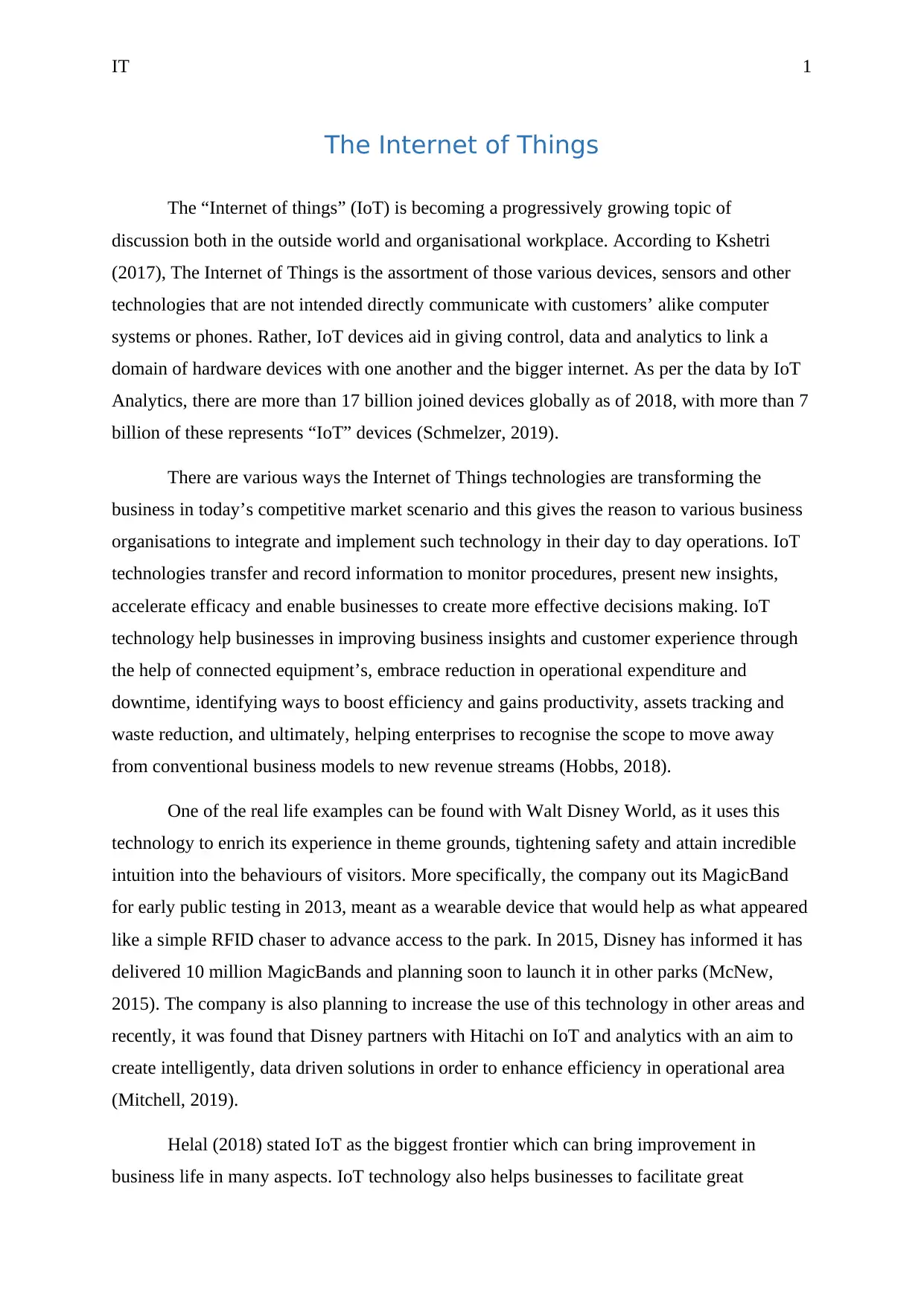
IT 1
The Internet of Things
The “Internet of things” (IoT) is becoming a progressively growing topic of
discussion both in the outside world and organisational workplace. According to Kshetri
(2017), The Internet of Things is the assortment of those various devices, sensors and other
technologies that are not intended directly communicate with customers’ alike computer
systems or phones. Rather, IoT devices aid in giving control, data and analytics to link a
domain of hardware devices with one another and the bigger internet. As per the data by IoT
Analytics, there are more than 17 billion joined devices globally as of 2018, with more than 7
billion of these represents “IoT” devices (Schmelzer, 2019).
There are various ways the Internet of Things technologies are transforming the
business in today’s competitive market scenario and this gives the reason to various business
organisations to integrate and implement such technology in their day to day operations. IoT
technologies transfer and record information to monitor procedures, present new insights,
accelerate efficacy and enable businesses to create more effective decisions making. IoT
technology help businesses in improving business insights and customer experience through
the help of connected equipment’s, embrace reduction in operational expenditure and
downtime, identifying ways to boost efficiency and gains productivity, assets tracking and
waste reduction, and ultimately, helping enterprises to recognise the scope to move away
from conventional business models to new revenue streams (Hobbs, 2018).
One of the real life examples can be found with Walt Disney World, as it uses this
technology to enrich its experience in theme grounds, tightening safety and attain incredible
intuition into the behaviours of visitors. More specifically, the company out its MagicBand
for early public testing in 2013, meant as a wearable device that would help as what appeared
like a simple RFID chaser to advance access to the park. In 2015, Disney has informed it has
delivered 10 million MagicBands and planning soon to launch it in other parks (McNew,
2015). The company is also planning to increase the use of this technology in other areas and
recently, it was found that Disney partners with Hitachi on IoT and analytics with an aim to
create intelligently, data driven solutions in order to enhance efficiency in operational area
(Mitchell, 2019).
Helal (2018) stated IoT as the biggest frontier which can bring improvement in
business life in many aspects. IoT technology also helps businesses to facilitate great
The Internet of Things
The “Internet of things” (IoT) is becoming a progressively growing topic of
discussion both in the outside world and organisational workplace. According to Kshetri
(2017), The Internet of Things is the assortment of those various devices, sensors and other
technologies that are not intended directly communicate with customers’ alike computer
systems or phones. Rather, IoT devices aid in giving control, data and analytics to link a
domain of hardware devices with one another and the bigger internet. As per the data by IoT
Analytics, there are more than 17 billion joined devices globally as of 2018, with more than 7
billion of these represents “IoT” devices (Schmelzer, 2019).
There are various ways the Internet of Things technologies are transforming the
business in today’s competitive market scenario and this gives the reason to various business
organisations to integrate and implement such technology in their day to day operations. IoT
technologies transfer and record information to monitor procedures, present new insights,
accelerate efficacy and enable businesses to create more effective decisions making. IoT
technology help businesses in improving business insights and customer experience through
the help of connected equipment’s, embrace reduction in operational expenditure and
downtime, identifying ways to boost efficiency and gains productivity, assets tracking and
waste reduction, and ultimately, helping enterprises to recognise the scope to move away
from conventional business models to new revenue streams (Hobbs, 2018).
One of the real life examples can be found with Walt Disney World, as it uses this
technology to enrich its experience in theme grounds, tightening safety and attain incredible
intuition into the behaviours of visitors. More specifically, the company out its MagicBand
for early public testing in 2013, meant as a wearable device that would help as what appeared
like a simple RFID chaser to advance access to the park. In 2015, Disney has informed it has
delivered 10 million MagicBands and planning soon to launch it in other parks (McNew,
2015). The company is also planning to increase the use of this technology in other areas and
recently, it was found that Disney partners with Hitachi on IoT and analytics with an aim to
create intelligently, data driven solutions in order to enhance efficiency in operational area
(Mitchell, 2019).
Helal (2018) stated IoT as the biggest frontier which can bring improvement in
business life in many aspects. IoT technology also helps businesses to facilitate great
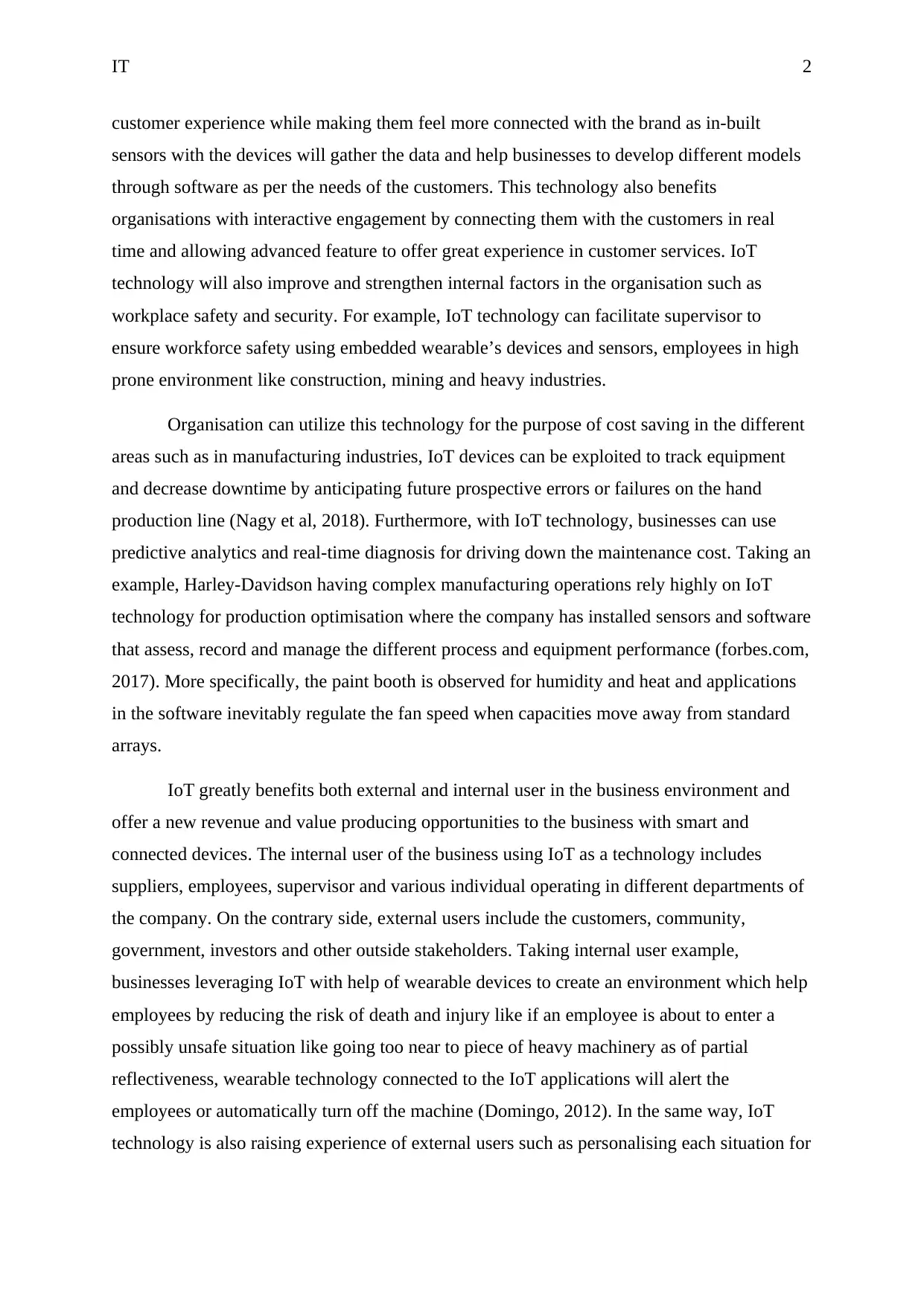
IT 2
customer experience while making them feel more connected with the brand as in-built
sensors with the devices will gather the data and help businesses to develop different models
through software as per the needs of the customers. This technology also benefits
organisations with interactive engagement by connecting them with the customers in real
time and allowing advanced feature to offer great experience in customer services. IoT
technology will also improve and strengthen internal factors in the organisation such as
workplace safety and security. For example, IoT technology can facilitate supervisor to
ensure workforce safety using embedded wearable’s devices and sensors, employees in high
prone environment like construction, mining and heavy industries.
Organisation can utilize this technology for the purpose of cost saving in the different
areas such as in manufacturing industries, IoT devices can be exploited to track equipment
and decrease downtime by anticipating future prospective errors or failures on the hand
production line (Nagy et al, 2018). Furthermore, with IoT technology, businesses can use
predictive analytics and real-time diagnosis for driving down the maintenance cost. Taking an
example, Harley-Davidson having complex manufacturing operations rely highly on IoT
technology for production optimisation where the company has installed sensors and software
that assess, record and manage the different process and equipment performance (forbes.com,
2017). More specifically, the paint booth is observed for humidity and heat and applications
in the software inevitably regulate the fan speed when capacities move away from standard
arrays.
IoT greatly benefits both external and internal user in the business environment and
offer a new revenue and value producing opportunities to the business with smart and
connected devices. The internal user of the business using IoT as a technology includes
suppliers, employees, supervisor and various individual operating in different departments of
the company. On the contrary side, external users include the customers, community,
government, investors and other outside stakeholders. Taking internal user example,
businesses leveraging IoT with help of wearable devices to create an environment which help
employees by reducing the risk of death and injury like if an employee is about to enter a
possibly unsafe situation like going too near to piece of heavy machinery as of partial
reflectiveness, wearable technology connected to the IoT applications will alert the
employees or automatically turn off the machine (Domingo, 2012). In the same way, IoT
technology is also raising experience of external users such as personalising each situation for
customer experience while making them feel more connected with the brand as in-built
sensors with the devices will gather the data and help businesses to develop different models
through software as per the needs of the customers. This technology also benefits
organisations with interactive engagement by connecting them with the customers in real
time and allowing advanced feature to offer great experience in customer services. IoT
technology will also improve and strengthen internal factors in the organisation such as
workplace safety and security. For example, IoT technology can facilitate supervisor to
ensure workforce safety using embedded wearable’s devices and sensors, employees in high
prone environment like construction, mining and heavy industries.
Organisation can utilize this technology for the purpose of cost saving in the different
areas such as in manufacturing industries, IoT devices can be exploited to track equipment
and decrease downtime by anticipating future prospective errors or failures on the hand
production line (Nagy et al, 2018). Furthermore, with IoT technology, businesses can use
predictive analytics and real-time diagnosis for driving down the maintenance cost. Taking an
example, Harley-Davidson having complex manufacturing operations rely highly on IoT
technology for production optimisation where the company has installed sensors and software
that assess, record and manage the different process and equipment performance (forbes.com,
2017). More specifically, the paint booth is observed for humidity and heat and applications
in the software inevitably regulate the fan speed when capacities move away from standard
arrays.
IoT greatly benefits both external and internal user in the business environment and
offer a new revenue and value producing opportunities to the business with smart and
connected devices. The internal user of the business using IoT as a technology includes
suppliers, employees, supervisor and various individual operating in different departments of
the company. On the contrary side, external users include the customers, community,
government, investors and other outside stakeholders. Taking internal user example,
businesses leveraging IoT with help of wearable devices to create an environment which help
employees by reducing the risk of death and injury like if an employee is about to enter a
possibly unsafe situation like going too near to piece of heavy machinery as of partial
reflectiveness, wearable technology connected to the IoT applications will alert the
employees or automatically turn off the machine (Domingo, 2012). In the same way, IoT
technology is also raising experience of external users such as personalising each situation for
⊘ This is a preview!⊘
Do you want full access?
Subscribe today to unlock all pages.

Trusted by 1+ million students worldwide
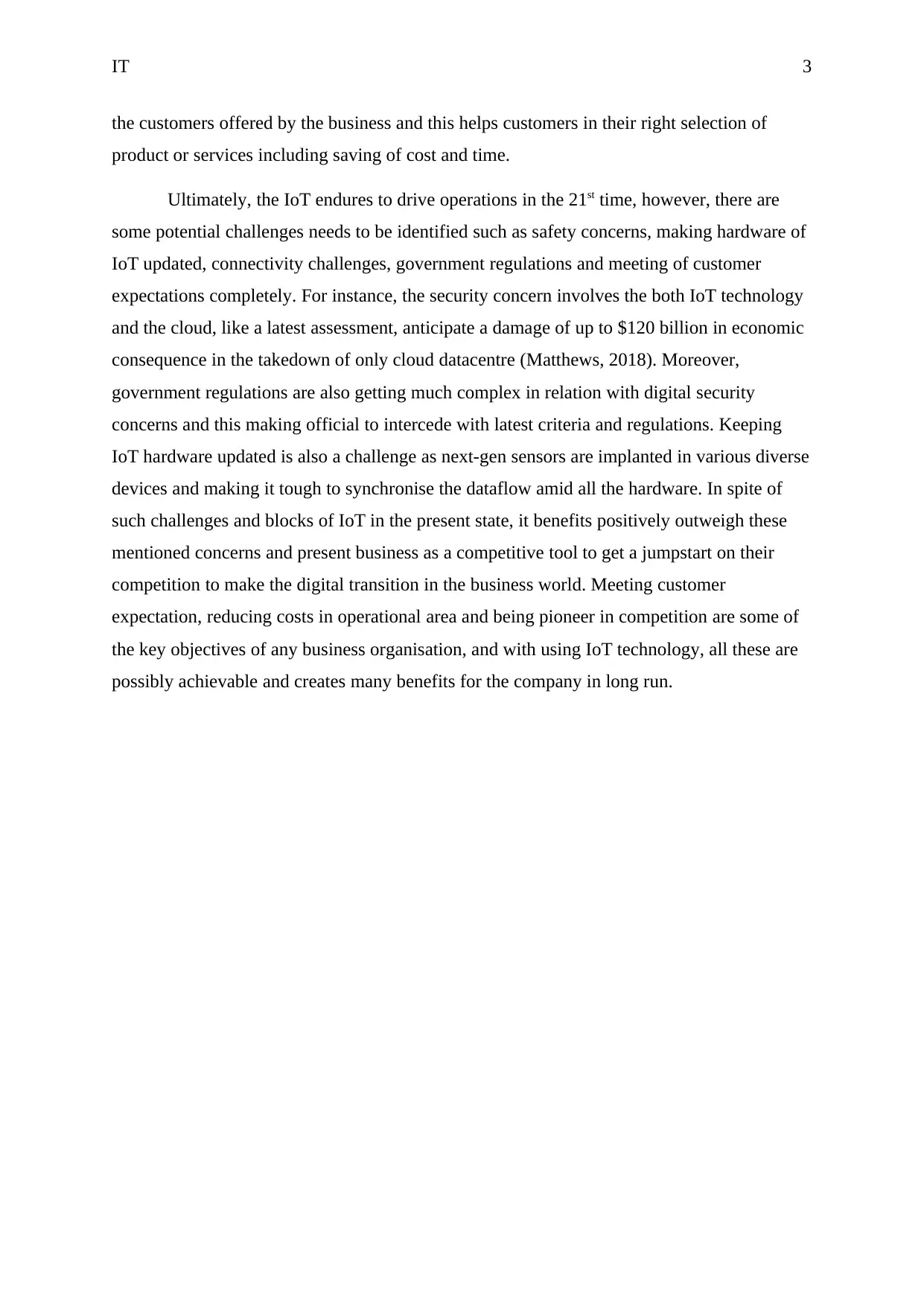
IT 3
the customers offered by the business and this helps customers in their right selection of
product or services including saving of cost and time.
Ultimately, the IoT endures to drive operations in the 21st time, however, there are
some potential challenges needs to be identified such as safety concerns, making hardware of
IoT updated, connectivity challenges, government regulations and meeting of customer
expectations completely. For instance, the security concern involves the both IoT technology
and the cloud, like a latest assessment, anticipate a damage of up to $120 billion in economic
consequence in the takedown of only cloud datacentre (Matthews, 2018). Moreover,
government regulations are also getting much complex in relation with digital security
concerns and this making official to intercede with latest criteria and regulations. Keeping
IoT hardware updated is also a challenge as next-gen sensors are implanted in various diverse
devices and making it tough to synchronise the dataflow amid all the hardware. In spite of
such challenges and blocks of IoT in the present state, it benefits positively outweigh these
mentioned concerns and present business as a competitive tool to get a jumpstart on their
competition to make the digital transition in the business world. Meeting customer
expectation, reducing costs in operational area and being pioneer in competition are some of
the key objectives of any business organisation, and with using IoT technology, all these are
possibly achievable and creates many benefits for the company in long run.
the customers offered by the business and this helps customers in their right selection of
product or services including saving of cost and time.
Ultimately, the IoT endures to drive operations in the 21st time, however, there are
some potential challenges needs to be identified such as safety concerns, making hardware of
IoT updated, connectivity challenges, government regulations and meeting of customer
expectations completely. For instance, the security concern involves the both IoT technology
and the cloud, like a latest assessment, anticipate a damage of up to $120 billion in economic
consequence in the takedown of only cloud datacentre (Matthews, 2018). Moreover,
government regulations are also getting much complex in relation with digital security
concerns and this making official to intercede with latest criteria and regulations. Keeping
IoT hardware updated is also a challenge as next-gen sensors are implanted in various diverse
devices and making it tough to synchronise the dataflow amid all the hardware. In spite of
such challenges and blocks of IoT in the present state, it benefits positively outweigh these
mentioned concerns and present business as a competitive tool to get a jumpstart on their
competition to make the digital transition in the business world. Meeting customer
expectation, reducing costs in operational area and being pioneer in competition are some of
the key objectives of any business organisation, and with using IoT technology, all these are
possibly achievable and creates many benefits for the company in long run.
Paraphrase This Document
Need a fresh take? Get an instant paraphrase of this document with our AI Paraphraser
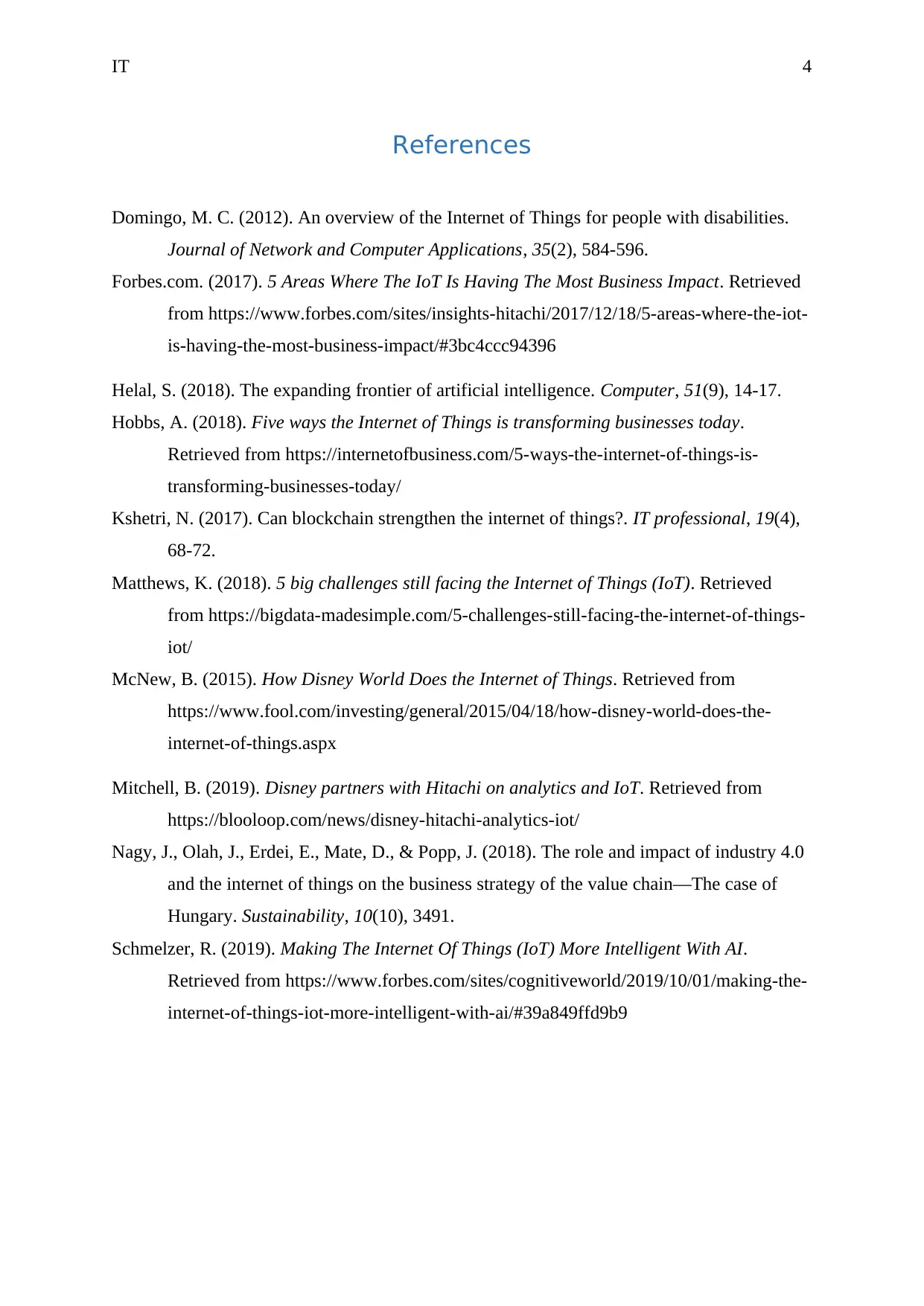
IT 4
References
Domingo, M. C. (2012). An overview of the Internet of Things for people with disabilities.
Journal of Network and Computer Applications, 35(2), 584-596.
Forbes.com. (2017). 5 Areas Where The IoT Is Having The Most Business Impact. Retrieved
from https://www.forbes.com/sites/insights-hitachi/2017/12/18/5-areas-where-the-iot-
is-having-the-most-business-impact/#3bc4ccc94396
Helal, S. (2018). The expanding frontier of artificial intelligence. Computer, 51(9), 14-17.
Hobbs, A. (2018). Five ways the Internet of Things is transforming businesses today.
Retrieved from https://internetofbusiness.com/5-ways-the-internet-of-things-is-
transforming-businesses-today/
Kshetri, N. (2017). Can blockchain strengthen the internet of things?. IT professional, 19(4),
68-72.
Matthews, K. (2018). 5 big challenges still facing the Internet of Things (IoT). Retrieved
from https://bigdata-madesimple.com/5-challenges-still-facing-the-internet-of-things-
iot/
McNew, B. (2015). How Disney World Does the Internet of Things. Retrieved from
https://www.fool.com/investing/general/2015/04/18/how-disney-world-does-the-
internet-of-things.aspx
Mitchell, B. (2019). Disney partners with Hitachi on analytics and IoT. Retrieved from
https://blooloop.com/news/disney-hitachi-analytics-iot/
Nagy, J., Olah, J., Erdei, E., Mate, D., & Popp, J. (2018). The role and impact of industry 4.0
and the internet of things on the business strategy of the value chain—The case of
Hungary. Sustainability, 10(10), 3491.
Schmelzer, R. (2019). Making The Internet Of Things (IoT) More Intelligent With AI.
Retrieved from https://www.forbes.com/sites/cognitiveworld/2019/10/01/making-the-
internet-of-things-iot-more-intelligent-with-ai/#39a849ffd9b9
References
Domingo, M. C. (2012). An overview of the Internet of Things for people with disabilities.
Journal of Network and Computer Applications, 35(2), 584-596.
Forbes.com. (2017). 5 Areas Where The IoT Is Having The Most Business Impact. Retrieved
from https://www.forbes.com/sites/insights-hitachi/2017/12/18/5-areas-where-the-iot-
is-having-the-most-business-impact/#3bc4ccc94396
Helal, S. (2018). The expanding frontier of artificial intelligence. Computer, 51(9), 14-17.
Hobbs, A. (2018). Five ways the Internet of Things is transforming businesses today.
Retrieved from https://internetofbusiness.com/5-ways-the-internet-of-things-is-
transforming-businesses-today/
Kshetri, N. (2017). Can blockchain strengthen the internet of things?. IT professional, 19(4),
68-72.
Matthews, K. (2018). 5 big challenges still facing the Internet of Things (IoT). Retrieved
from https://bigdata-madesimple.com/5-challenges-still-facing-the-internet-of-things-
iot/
McNew, B. (2015). How Disney World Does the Internet of Things. Retrieved from
https://www.fool.com/investing/general/2015/04/18/how-disney-world-does-the-
internet-of-things.aspx
Mitchell, B. (2019). Disney partners with Hitachi on analytics and IoT. Retrieved from
https://blooloop.com/news/disney-hitachi-analytics-iot/
Nagy, J., Olah, J., Erdei, E., Mate, D., & Popp, J. (2018). The role and impact of industry 4.0
and the internet of things on the business strategy of the value chain—The case of
Hungary. Sustainability, 10(10), 3491.
Schmelzer, R. (2019). Making The Internet Of Things (IoT) More Intelligent With AI.
Retrieved from https://www.forbes.com/sites/cognitiveworld/2019/10/01/making-the-
internet-of-things-iot-more-intelligent-with-ai/#39a849ffd9b9
1 out of 5
Related Documents
Your All-in-One AI-Powered Toolkit for Academic Success.
+13062052269
info@desklib.com
Available 24*7 on WhatsApp / Email
![[object Object]](/_next/static/media/star-bottom.7253800d.svg)
Unlock your academic potential
Copyright © 2020–2025 A2Z Services. All Rights Reserved. Developed and managed by ZUCOL.





